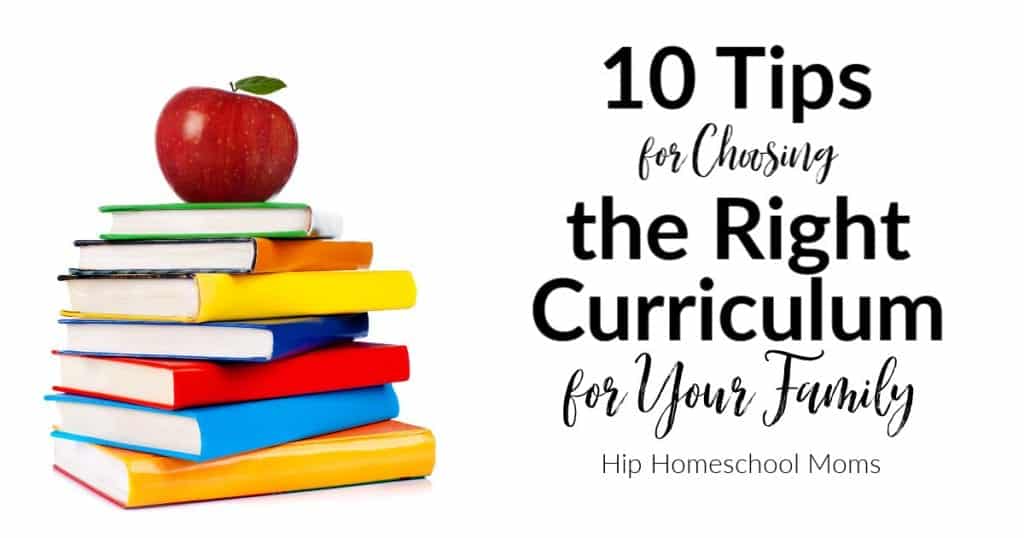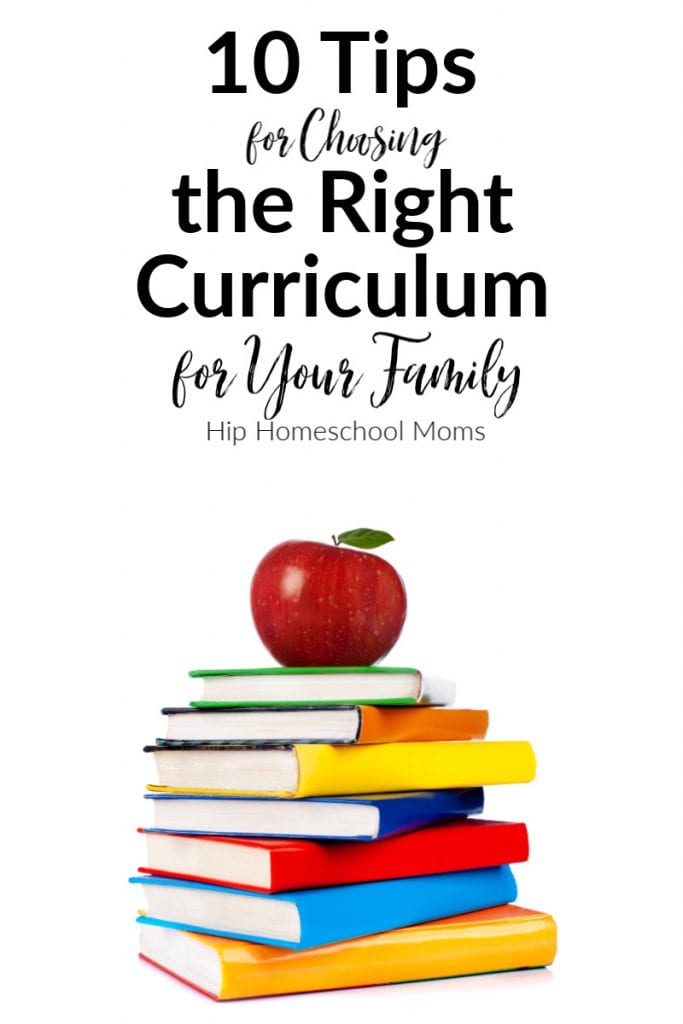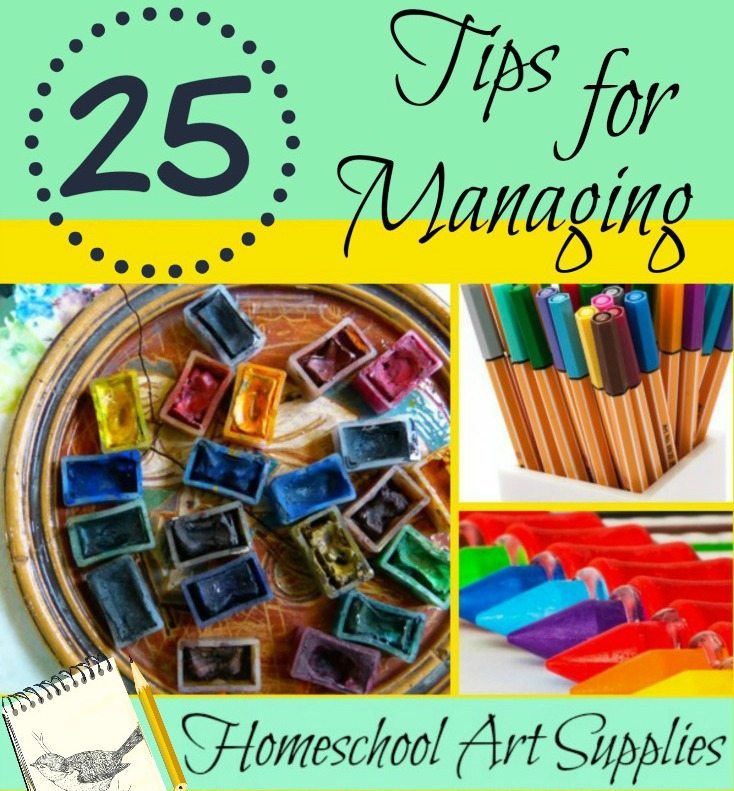Dear Mom Who’s Considering Homeschooling: 10 Tips for Choosing the Right Curriculum
The biggest question that most moms who are considering homeschooling have is, “How do I choose the right curriculum?” Just because a curriculum looks nice or seems interesting doesn’t mean it will work well for you and your family. There are several factors that need to be considered.

1. What is your child’s learning style?
Many (if not most) young children enjoy hands-on activities. Most of these young students will learn best by moving around, singing songs with motions, dancing, coloring, drawing, playing with playdough, painting, cutting with scissors, cooking with Mom or Dad, helping with chores inside or outside the house, or any other active, hands-on activities.
As our children get older (maybe around 4th or 5th grade) they begin to develop more specific likes and dislikes. (Of course some children do this earlier and some later.) If you have trouble defining your student’s learning style, there are books and online questionnaires that can help you pinpoint it. Or you can take a look at our article What Is Your Child’s Learning Style? to help you figure it out.
2. What is your teaching style?
One important thing that many homeschooling moms don’t think to consider is that you must find curriculum that you like and that will work well for you. Of course it’s very important for your curriculum to be a good fit for your child, but if you hate teaching it, you’ll have a hard time doing a good job of it. (Another post in this series, Dear Mom Who’s Considering Homeschooling: Where to Find Curriculum, gives tips on where to find curriculum.) If you find a curriculum that you think will work well for your child, consider how much you think you will enjoy it too. If you don’t think it will fit your teaching style, consider whether you can make a few changes so that you can enjoy the curriculum too. If not, you may need to choose another curriculum that you and your child can both enjoy.
3. What is your philosophy?
Do you want to use a Christian curriculum? Do you prefer secular curriculum? There are some great Christian curriculums available now. There are also some very good secular curriculums available. Be sure to investigate whatever curriculum you’re considering to find out if it fits with your views. If it doesn’t support your views, you can choose to discuss with your child why you feel differently than the author of the resource. Or you can choose (particularly with younger children) to leave out whatever conflicts with your views. (At older ages, I don’t suggest doing this, but at younger ages it might be best. This will depend upon the maturity of your child and what he will understand at his age.)
4. How much time do you plan to spend teaching?
If you plan to spend most of your child’s school hours teaching him, then you are free to choose curriculum that calls for a lot of parent teaching/participation. When my children were younger (about kindergarten through 5th or 6th grades), I did a lot of teaching and interacting with them while they “did school.” As they’ve gotten older, I’ve done more supervising and less teaching.
If you don’t have time (or for some other reason aren’t able) to spend most of your child’s school time teaching or assisting, you’ll need to keep that in mind when you choose curriculum. Try to be realistic about how much hands-on time you can spend. If you overestimate how much time you’ll be able to spend teaching, it can make for a difficult year!
5. How many children do you plan to teach at once?
If you have only one child, you may choose any curriculum that fits that child and the you (the parent/teacher). If you plan to teach more than one child, however, you’ll need to either choose a curriculum that’s meant for multiple children, or you can adapt your curriculum to fit more than one child. Sometimes this is as easy as buying enough workbooks or activity books (or other consumable materials that go with your curriculum) for all of your children instead of just buying one. Unit studies are often easily adapted for multiple children, but if unit studies aren’t for your family, don’t be afraid to adapt whatever other curriculum you like. Yet another option is having different curriculums for different children to be taught at different times, but this could be hard to carry out.
6. How much money do you have to spend?
Your budget is probably going to play a pretty big role in “helping” you choose your curriculum. If you have a limited budget, you’ll need to carefully consider each purchase and make sure you don’t spend too much in any one area to the detriment of another. It may be particularly important for you, if possible, to choose curriculum that can be used by more than one student and for students in different age ranges. You may want to look for used curriculum sales (online or those held by local homeschool groups) or even look on eBay. Curriculum companies often have sales or offer free shipping if you order during the months of April or May. There are also almost always deals to take advantage of at homeschool conventions. (Please keep in mind that, if you stop at a particular company’s booth for information and to discuss the curriculum with the vendor, it is important that you then buy your curriculum from that vendor.)
7. Do you plan to reuse the curriculum with other children? Do you plan to sell it once you’re finished with it?
Something to keep in mind is that, if you plan to use your curriculum with other children in future years, you may need to go ahead and buy extra workbooks or other necessary resources now–not later. Many curriculum companies update their books and materials every 5 or so years. If the book you’re using is updated before your next child uses it, the edition of the workbook that you need may no longer be available for purchase. Also, buying extra workbooks now keeps you from having to pay a higher price later if the same workbook is still available.
8. Are you prepared to scrap the curriculum you’re using if it doesn’t prove to work well for your child or for you?
Keep in mind that it’s very possible you may need to scrap the curriculum you’ve chosen for one or more subjects–especially if you’re just beginning to homeschool. I’ve found that it takes many homeschooling families two or three years to settle on a curriculum that works well and that they really like. It definitely took me about 3 years to find exactly what worked for us when we first began homeschooling many years ago. Then a few years ago, I had to switch gears again because my older two were entering their high school years! And of course my youngest child learns in completely different ways than her older two siblings, so I had to “from scratch” again with her!
What I try to keep in mind is that, if a particular curriculum doesn’t work well for us, we’ll sell it and use the money to buy (or help pay for) another curriculum that works well for us. For that reason, I usually don’t have my students write in their notebooks or workbooks for the first couple of weeks or so of starting a new curriculum. I use it for a few weeks first, make sure it seems to work well for us, and then allow my child to write in the workbook. I also sometimes choose to go ahead and buy an extra workbook so that, in the future when I’m ready to sell the curriculum, I can offer the entire set to the buyer.
Be sure to remember that, if it’s at all possible, it really is better to set aside a curriculum that just isn’t working and look for something else. Yes, it costs more money to change curriculum, but it will be worth it in the long run! You don’t want to spend an entire school year being miserable and hating school.
9. Have you read reviews of the curriculum in order to learn as much as you can about it before making a decision?
I always suggest reading some reviews of a particular curriculum before settling on it. You should not base your entire decision on a few negative (or even positive) reviews. You should, though, read the reviews to find out if perhaps there’s something about the curriculum that you haven’t noticed or wouldn’t have had another way to know about. In other words, maybe the math curriculum you’re considering includes lots of busy work. If that’s the case, you’ll know that you either need to be willing to leave off some of the busy work so your child won’t get bored and frustrated, or you’ll need to choose a different curriculum. Another example could be a review pointing out that a history curriculum includes lots of art projects and craft activities. If you have a child who would love that, then you’ve gotten some valuable information from that review! If you have a child who’s not into arts and crafts at all, you’ve also gotten some helpful information, and you’ll know to avoid that curriculum.
10. Have you been able to put your hands on the curriculum you’re considering?
I always tell moms who are making curriculum decisions that there’s no substitute for actually taking a hands-on look at the curriculums you’re considering using. If you can’t make it to a homeschool convention or curriculum fair, maybe you can attend a local used curriculum sale or swap. You may even be able to meet with some moms in a local homeschool group to give all of you a chance to get a hands-on look at the other moms’ curriculums.












Fabulous suggestions, Wendy! All great ideas – I really applaud you including both the student’s learning style AND the teacher’s style as well!
You may also want to ask what, if any, return policy the publisher offers.
Blessings all!
Kym